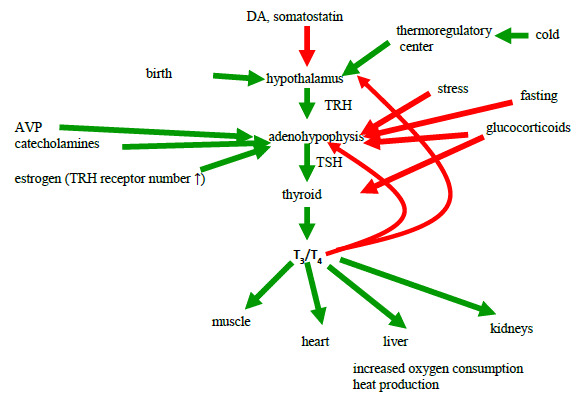III.3.G. The effects of thyroid hormones
The thyroid hormones have effects on various parts of the body (Fig. 10).
The fetal pituitary produces thyroid stimulating hormone (TSH) from the 11th week, and T4 and T3 from the 16th week.
The half-lives of the hormones are long (T4 = 7 days, T3 = 1 day).
These hormones are transferred by binding proteins (T4-binding globulin (TBG) 75%, T4-binding prealbumin (TBPA) 15%, albumin 10%).
General effects
They enhance oxidation pathways and metabolism ![]() , thereby ensuring energy for the body functions.
, thereby ensuring energy for the body functions.
The O2 demand of organs ![]() (except for: the brain, testis, uterus, spleen, thyroid and tumor cells).
(except for: the brain, testis, uterus, spleen, thyroid and tumor cells).
An insufficiency or an excess of thyroid hormones inhibit ovulation.
Lipid metabolism:
In the brown adipose tissue (β3-rec.): lipolysis ![]() .
.
The level and oxidation of FFA ![]() .
.
The plasma TG level ![]() .
.
The cholesterol level ![]() (but the LDL receptor number
(but the LDL receptor number ![]() ).
).
Glu metabolism:
Glycogenolysis in the liver ![]() .
.
Gluconeogenesis in the liver ![]() .
.
Glu uptake by the muscles ![]() , the number of GLUT-4 transporters
, the number of GLUT-4 transporters ![]() (insulin-independent effects).
(insulin-independent effects).
Protein metabolism:
All steps ![]() , leading to a negative nitrogen balance.
, leading to a negative nitrogen balance.
Peripheral resistance ![]() (tissue metabolism
(tissue metabolism ![]() and vasodilatation-inducing metabolites are released).
and vasodilatation-inducing metabolites are released).
Energy homeostasis:
Heat production ![]() (calorigenic effect) – cold adaptation
(calorigenic effect) – cold adaptation ![]() .
.
O2 consumption ![]() .
.
Effects on the heart :
Catecholamine sensitivity![]() .
.
Beta-adrenergic receptor number ![]() .
.
Stroke volume ![]() .
.
G protein amount ![]() , heart frequency
, heart frequency![]() , which means a positive chronotropic effect (the heart contracts with greater frequency).
, which means a positive chronotropic effect (the heart contracts with greater frequency).
Cardiac output ![]() .
.
G protein amount ![]() , heart muscle (myocardium) contractility
, heart muscle (myocardium) contractility ![]() , which means a positive inotropic effect (the heart contracts more strongly).
, which means a positive inotropic effect (the heart contracts more strongly).
Gastrointestinal effects:
Motility ![]() .
.
Glu absorption ![]() .
.
Effects on the nervous system:
It stimulates postnatal development,
the early development of all organs (this is important mainly in the development of the brain up to 3 years of age), and
synapse development, differentiation and myelinization.
It is important for the maintenance of normal reflex irritability.

Figure 10. The regulation of the thyroid hormones
(ADH, AVP = arginine vasopressin or antidiuretic hormone, TRH = TSH-releasing hormone, TSH = thyroid-stimulating hormone, T3 = triiodothyronine, T4 = thyroxine, DA = dopamine;
red arrow = inhibition, green arrow = stimulation)